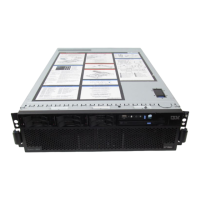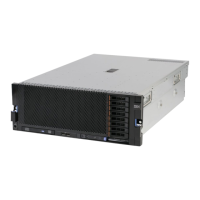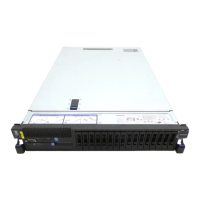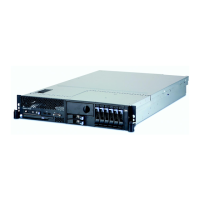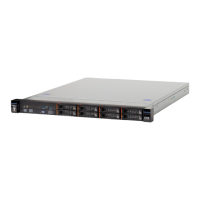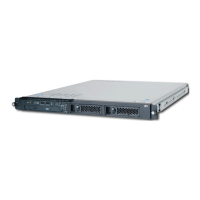v Follow the suggested actions in the order in which they are listed in the Action column until the problem
is solved.
v See Chapter 3, “Parts listing, Type 8864,” on page 23 to determine which components are customer
replaceable units (CRU) and which components are field replaceable units (FRU).
v If an action step is preceded by “(Trained service technician only)”, that step must be performed only by a
trained service technician.
Power-supply
LEDs
Operator
information
panel power
LED Description Action
AC
good
DC
good
Off Off Off No power to the
server, or a problem
with the ac power
source.
1. Check the ac power to the server.
2. Make sure that the power cord is connected to a
functioning power source.
3. Remove one power supply at a time.
Lit Off Off DC source power
problem
1. Make sure that the microprocessor tray is connected
to the power backplane.
2. Remove one power supply at a time.
3. View the system-error log (see “Error logs” on page
70).
Lit Lit Off Standby power
problem
1. View the system-error log (see “Error logs” on page
70).
2. Isolate by removing one power supply at a time.
3. (Trained service technician only) Replace the power
backplane.
Lit Lit Flashing System power-on
problem
1. View the system-error log (see “Error logs” on page
70).
2. Press the power-control button on the operator
information panel.
3. (Trained service technician only) Use the
force-power-on jumper as a debugging aid (see “I/O
board internal connectors and jumpers” on page 8) to
determine whether the information panel switch and
cable are faulty.
4. Remove the optional Remote Supervisor Adapter II
SlimLine, and try to turn on the server.
5. Reseat the microprocessor tray.
6. (Trained service technician only) Replace the
microprocessor tray.
Lit Lit Lit The power is good. No action.
Diagnostic programs, messages, and error codes
The server diagnostic programs are the primary method of testing the major
components of the server.
As you run the diagnostic programs, text messages and error codes are displayed
on the screen and are saved in the test log. A diagnostic text message or error
code indicates that a problem has been detected; to determine what action you
should take as a result of a message or error code, see the table in “Diagnostic
error codes” on page 112.
110 IBM System x3850 Type 8864: Problem Determination and Service Guide

